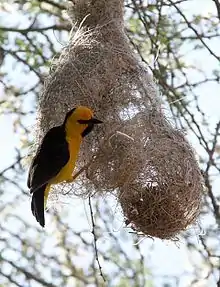Black-necked weaver
The black-necked weaver (Ploceus nigricollis) is a resident breeding bird species in much of tropical Africa from Senegal and northern Angola to South Sudan and Tanzania.
| Black-necked weaver | |
|---|---|
 | |
| Scientific classification | |
| Kingdom: | Animalia |
| Phylum: | Chordata |
| Class: | Aves |
| Order: | Passeriformes |
| Family: | Ploceidae |
| Genus: | Ploceus |
| Species: | P. nigricollis |
| Binomial name | |
| Ploceus nigricollis (Vieillot, 1805) | |
Taxonomy and systematics
The species was first described by Louis Jean Pierre Vieillot in 1805, who named it Malimbus nigricollis. The description was based on a specimen that had been collected by Jean Perrein near Malimbe, French for the town Malembo, in the Cabinda Province of Angola. The species epithet nigricollis is a contraction of two Latin words, niger meaning "black", and collis, meaning "necked".[2]
Subspecies
There are four subspecies recognized:[3]
- P. n. brachypterus - Swainson, 1837: Found from Senegal and Gambia to western Cameroon
- P. n. nigricollis - (Vieillot, 1805): Found from eastern Cameroon to southern Sudan, western Kenya, north-western Tanzania, southern Democratic Republic of Congo and Angola
- P. n. po - Hartert, 1907: Found on Bioko
- P. n. melanoxanthus - (Cabanis, 1878): Found from southern Ethiopia and southern Somalia to central and eastern Kenya and north-eastern Tanzania
Description
The black-necked weaver is a stocky 16 cm bird with a strong conical bill. The adult male of the northern race has olive upper-parts and wings, and yellow underparts and head. It has a black eye-mask and bib, and a pale yellow iris. The non-breeding male has a yellow head with an olive crown, grey upper-parts and whitish. The wings remain yellow and black.

The adult female also has olive upper-parts and wings, and yellow underparts and head. It has a black eyemask but no bib.
The southern race found from Nigeria eastwards has a quite different appearance, with almost black upper-parts and tail.
The black-necked weaver feeds on insects and vegetable matter. The calls of this bird include a wheezing dew-dew-twee .
Behaviour and ecology
It builds a large coarsely woven nest made of grass and creepers with a 15 cm downward facing entrance tunnel hanging from the globular egg chamber. The nest is suspended from a branch in a tree and 2-3 eggs are laid. It nests in pairs but forms small flocks when not breeding.
References
- BirdLife International (2012). "Ploceus nigricollis". IUCN Red List of Threatened Species. 2012. Retrieved 26 November 2013.CS1 maint: ref=harv (link)
- "Black-necked Weaver Ploceus nigricollis". Weaver Watch. Retrieved 10 June 2017.
- Gill, Frank; Donsker, David, eds. (2018). "Old World sparrows, snowfinches, weavers". World Bird List Version 8.2. International Ornithologists' Union. Retrieved 28 November 2018.
- Birds of The Gambia by Barlow, Wacher and Disley, ISBN 1-873403-32-1
External links
- Black-necked weaver - Species text in Weaver Watch.

